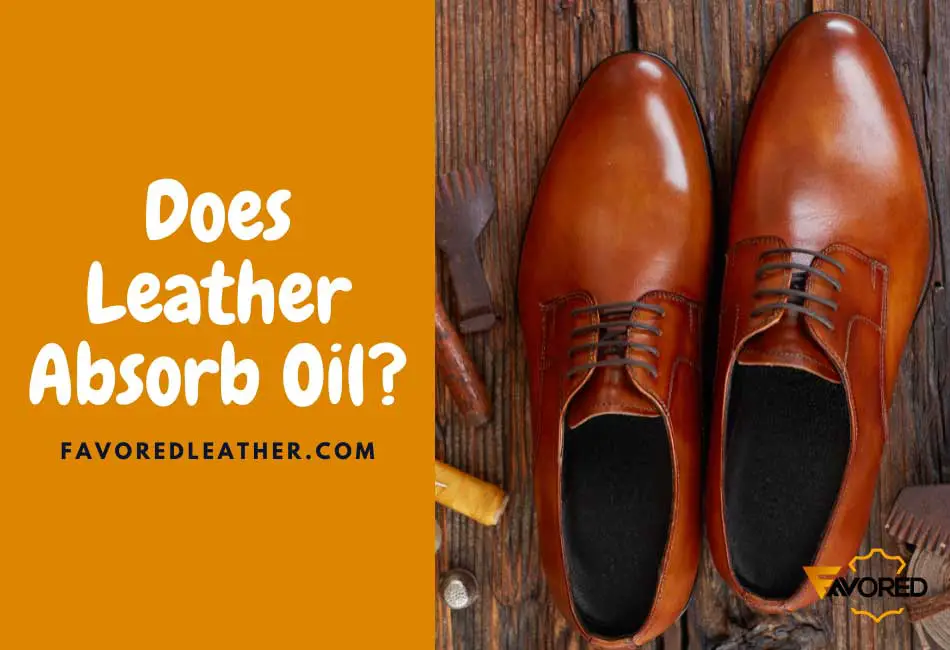Leather is a popular choice for upholstery and furniture due to its natural durability and classic look. Oil stains are a common type of stain that can be difficult to remove from leather. What makes it difficult? Is it because the leather absorbs the oil?
I decided to put this theory to the test. I applied a small amount of oil on six different types of leather, including full-grain leather, top-grain leather, genuine leather, suede or split grain, bonded leather, and faux leather. I then waited for 30 minutes to about an hour.
This is a summary of the results. All of the leather absorbed the oil except faux leather and bonded leather. The suede and full-grain leather absorbed the most oil the fastest, while the top-grain and genuine leather absorbed less. The bonded leather and faux leather didn’t absorb any oil at all, mainly because of the plastic coating on them.
Let’s take a closer look at how each of these leathers fared!
Test 1: Full-grained Leather And Oil Absorption
Full-grain leather is the highest quality of leather you can get. It’s made from the outermost layer of the hide, so it includes all of the natural markings and grain patterns.
Because it’s not buffed, sanded, or coated like other types of leather, full-grain leather is more susceptible to staining.
In this test, the full-grain leather absorbed the most oil out of all the types of leather. And it did so within the first 3 to 5 minutes of the oil being applied.
This is mainly because full-grain leather is more porous than other types of leather. This means it has tiny holes or pores that allow any type of liquid to get into it.
So when oil is applied to the surface of full-grain leather, it soaks right in, and not only that, it will soak in the fastest out of all the types of leather.
Test 2: Top Grain Leather And Oil Absorption
Top-grain leather is the second highest quality of leather. It’s made from the outermost layer of the hide, but unlike full-grain leather, it has been buffed and sanded to remove any natural markings or grain patterns.
This process makes top-grain leather more resistant to staining, but it’s still not as resistant as other types of leather.
In this test, the top-grain leather absorbed less oil than the full-grain leather, but it still absorbed a fair amount. It took about 15 to 20 minutes for the oil to be fully absorbed.
This is because top-grain leather is less porous than full-grain leather, but it’s still more porous than other types of leather.
So while the oil didn’t soak in as quickly, it could still penetrate the surface and be absorbed.
Test 3: Genuine Leather And Oil Absorption
Genuine leather is made from the innermost layer of the hide, so it doesn’t include any of the natural markings or grain patterns. The genuine leather is also known as corrected grain leather.
Genuine leather tends to be tough in texture because it comes from the innermost part of the hide.
Very similar to top-grain leather, genuine leather is often sanded and buffed to create a more consistent look.
Not only that, the surface of genuine leather is often spray painted and embossed with patterns that look like leather–hence the name corrected grain leather.
These corrections make genuine leather less porous than full-grain and top-grain leather. But it still retains a bit of porosity, which is why it absorbed some of the oil in this test.
It took about 30 to 40 minutes for the oil to start getting absorbed into the genuine leather. And even then, it didn’t absorb as much oil as the full-grain or top-grain leather.
Test 4: Suede And Oil Absorption
Suede is made from the innermost layer of the hide, just like genuine leather. The difference is that suede is finished with a brushed or napped surface. This gives it a softer, more velvety feel.
Suede is also more susceptible to staining than other types of leather because of its napped finish. The tiny fibers on the surface can easily trap liquids and dirt.
In this test, the suede absorbed oil within the first few seconds. The oil quickly absorbed, leaving almost no trace of oil stain–since I used a dark-colored suede leather.
As I mentioned, suede is super porous and absorbent. So it’s not surprising that it would absorb oil so quickly and easily.
Test 5: Faux Leather And Oil Absorption
Faux leather, also known as PU leather, is a man-made material that’s designed to look and feel like real leather.
It’s made from a synthetic polymer called polyurethane, which is combined with other materials like plasticizers and fabric backing.
Faux leather is often used in upholstery, clothing, and shoes. It’s also used to make things like book bindings and wallets.
In this test, the faux leather did not absorb any oil. The oil just sat on the surface and didn’t penetrate at all, even after 24 hours.
This is because faux leather is non-porous, so it doesn’t have any tiny holes or pores that would allow liquids to seep in.
So while faux leather may look and feel like real leather, it doesn’t have the same absorbent properties.
Test 6: Bonded Leather And Oil Absorption
Bonded leather is made from bits of leftover leather that are shredded or ground up and then bonded together with adhesives. It’s often used in upholstery, clothing, and shoes.
The surface of bonded leather is usually coated with a polyurethane or PVC layer. This gives it a smooth, consistent look and water-resistant finish.
In this test, bonded leather did not absorb any oil, just like faux leather. The oil just sat on the surface and didn’t penetrate at all.
Bonded leather may also look and feel like real leather, but it doesn’t have the same absorbent properties because it’s non-porous.
Final Thoughts
After testing out six different types of leather, it’s clear that not all leather is created equal.
When it comes to oil absorption, suede, full-grain, and top-grain leather are the most absorbent.
Genuine leather is also somewhat absorbent, but not as much as the other three types.
Faux leather and bonded leather are not absorbent at all because they’re non-porous.
Do you have any experience with oil and leather? Let me know in the comments below! And be sure to check out my other blog posts for more interesting articles about all things leather.
Thanks for reading!

